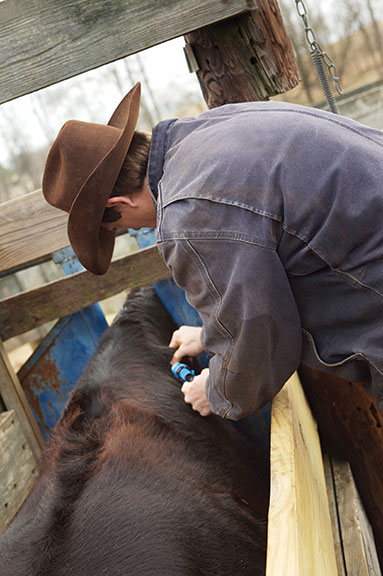Deciding when and how to treat is the big question.
The timing of deworming, the form of treatment and the dosage used can all have a huge impact on effectiveness, according to experts.
Getting it right will likely make your animals more productive – and you more profitable.
A number of good dewormers are now available, but producers need to make sure the product they use is a good match for the target parasite, says Shannon Williams, a University of Idaho extension educator.
“Read the label and talk to your veterinarian,” she advises. “There is no reason to give that dewormer to your cattle if it isn’t going to get the parasites they’re packing around.”

Measure the impact
A number of parasites, including roundworms, tapeworms and liver flukes can infect beef cattle, resulting in reduced production whether measured by average daily weight gain, lactation or other factors.
Some studies have estimated that gastrointestinal parasites may cost U.S. cattle producers from $25 to $200 per animal every year.
Flukes, whose life cycle depends on snails, are a big concern in mountainous areas because most of the private pasture is low-lying meadows.
Flukes can cause liver damage, resulting in weight loss, diarrhea and condemnation of beef livers at processing.
“Most flukicide products will not work on immature flukes, so timing the treatment until the flukes are mature is critical,” Williams says.
Cattle can easily be infected with internal parasites without showing any outward signs – a situation that vets call subclinical.
Let’s say a producer has some stocker steers on good-quality forage that should allow the animals to gain 1.5 to two pounds per day, but instead the animals are gaining just one to 1.25 pounds per day because of internal parasites.
The losses can add up in a hurry, says Larry Hollis, a professor of veterinarian medicine at Kansas State University.
“We have a tremendous amount of weight gain that is never realized because of subclinical worms,” Hollis says.
Internal parasites can also worsen any other health problems cattle already have, Hollis says.
“If we have worms and another disease happening concurrently, it will nearly always allow that other disease to be worse than it normally would have been,” he says.
“If you have pneumonia going in a set of calves, it will be worse in those that are wormy.”
Take the fight to the bugs
When should producers deworm their cattle? Timing is critical.
The better producers generally deworm before moving cattle to summer pasture, and then again in the fall after the first hard freeze if they’re using winter pasture, Hollis says.
“One of the things that gives you the most bang for the buck is to deworm cattle and then move them to clean pasture simultaneously,” he says.
Jeremy Powell, an extension veterinarian with the University of Arkansas in Fayetteville, recommends Arkansas producers deworm cattle around March 15. Roundworms are the biggest concern.
“We see an increase in egg production in the spring,” Powell says. “It’s best if a producer can come in and clean out the cows before you see that spring rise effect.”
Ideally, the timing of treatment would be based on strategic factors such as the parasites’ life cycle, level of infection and pasture/environmental conditions, experts say.
Producers are encouraged to take fecal samples to determine the number of worm eggs per gram of manure and use that to help determine when they should treat.
But such a strategic deworming program is a lot easier to recommend than it is to carry out.
“I would say that it would be most optimal for producers to (deworm) strategically, working with their veterinarian, but I also realize that sometimes it takes a lot of help and labor to gather and work cattle,” Powell says.
“Sometimes we have no other alternative other than to (deworm) when we have the cattle in the corral.”
Eighty-five percent of cattle operations that deworm their animals do so based on a regular schedule, according to a 2007-2008 cow-calf survey conducted by the USDA’s National Animal Health Monitoring System. Ten percent reported that they deworm when their cattle look rough.
Only 5.7 percent of operators performed any testing of fecal samples to evaluate parasite burdens in their cattle.
Know your method
How the dewormer is administered is also important. Pour-on and oral feed forms are convenient, but the amount that each animal gets can be highly variable.
“If you’re really after worms, use the injectable form,” Hollis advises.
“A lot of people like to use pour-on for convenience, but those will never do as good a job of deworming as the injectable forms of the same product,” he says.
“Ivomec injectable will do a better job, hands-down every time, than Ivomec pour-on, and the same thing with Dectomax.”
The other thing producers need to watch is dosage, Hollis says.
Producers tend to deworm their herds based on an average weight and that can mess them up a bit, he says.
“The average weight of beef cows across the U.S. is now about 1,400 pounds. Most people don’t realize that,” Hollis says.
If a producer has some 1,600-pound cows and some 1,100-pound cows, but is treating for a 1,200-pound average, it’s going to result in uneven dosing.
There’s growing evidence that internal parasites are developing resistance to some dewormers, and experts believe underdosing may be a primary cause.
Few cow-calf operations are set up to weigh each individual animal, so what’s a producer to do?
Some experts now recommend the dosage be based on the heaviest animals in the herd rather than an average.
“You need to make sure your bigger animals are getting enough to treat them effectively,” Hollis says. ![]()
Dave Wilkins is a freelance writer based in Twin Falls, Idaho.
PHOTO
While pour-on dewormers add convenience, administering an injectable dewormer can provide more efficacy to the cattle. Photo courtesy Wilda Courney Photography.






